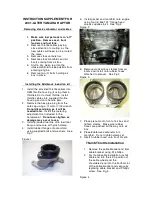
07 Wheels and tires
Uniform Tire Quality Grading
07
177
ALL PASSENGER VEHICLE TIRES MUST
CONFORM TO FEDERAL SAFETY
REQUIREMENTS IN ADDITION TO THESE
GRADES
Quality grades can be found, where appli-
cable, on the tire sidewall between the tread
shoulder and maximum section width. For
example:
Treadwear 200 Traction AA Temperature A
TREADWEAR
The treadwear grade is a comparative rating
based on the wear rate of the tire when tested
under controlled conditions on a specified gov-
ernment test course. For example, a tire gra-
ded 150 would wear one and one half (1 1/2)
times as well on the government course as a
tire graded 100. The relative performance of
tires depends upon the actual conditions of
their use, however, and many depart signifi-
cantly from the norm due to variation in driving
habits, maintenance practices and differences
in road characteristics and climate.
TRACTION
The traction grades, from highest to lowest, are
AA, A, B, and C, as measured under controlled
conditions on specified government test sur-
faces of asphalt and concrete. A tire marked C
may have poor traction performance.
WARNING
The traction grade assigned to this tire is
based on braking (straight-ahead) traction
tests and is not a measure of cornering
(turning) traction.
TEMPERATURE
The temperature grades are AA (the highest),
A, B, and C, representing the tire's resistance
to the generation of heat and its ability to dis-
sipate heat when tested under controlled con-
ditions on a specified indoor laboratory test
wheel. Sustained high temperature can cause
the material of the tire to degenerate and
reduce tire life, and excessive temperature can
lead to sudden tire failure. The grade C corre-
sponds to a minimum level of performance that
all passenger vehicle tires must meet under the
Federal Motor Safety Standard No. 109.
Grades B and A represent higher levels of per-
formance on the laboratory test wheel than the
minimum required by law.
WARNING
The temperature grade for this tire is estab-
lished for a tire that is properly inflated and
not overloaded. Excessive speed, under-
inflation, or excessive loading, either sepa-
rately or in combination, can cause heat
buildup and tire failure.
Summary of Contents for 2010 XC90
Page 1: ...VOLVO XC90 Owner s Manual Web Edition ...
Page 2: ......
Page 8: ...Contents 8 12 12 Index Index 280 ...
Page 9: ...Contents 9 ...
Page 15: ...01 SAFETY ...
Page 49: ...01 Safety 01 49 ...
Page 51: ...02 INSTRUMENTS AND CONTROLS ...
Page 52: ...02 Instruments and controls Instrument overview 02 52 G000000 ...
Page 89: ...03 CLIMATE ...
Page 99: ...04 INTERIOR ...
Page 109: ...04 Interior Storage compartments 04 109 G033089 ...
Page 118: ...118 Remote keys and key blades 120 Locking and unlocking 124 Child safety locks 126 Alarm 127 ...
Page 119: ...05 LOCKS AND ALARM ...
Page 129: ...06 STARTING AND DRIVING ...
Page 165: ...07 WHEELS AND TIRES ...
Page 191: ...07 Wheels and tires 07 191 ...
Page 192: ...G020920 192 Washing and cleaning the vehicle 194 Paint touch up 198 ...
Page 193: ...08 CAR CARE ...
Page 199: ...08 Car care 08 199 ...
Page 201: ...09 MAINTENANCE AND SERVICING ...
Page 235: ...09 Maintenance and servicing 09 235 ...
Page 237: ...10 AUDIO ...
Page 263: ...11 SPECIFICATIONS ...
Page 264: ...11 Specifications Label information 11 264 ...
Page 279: ...11 Specifications 11 279 ...
Page 286: ...12 Index 12 286 ...
Page 287: ......
Page 288: ...Kdakd 8Vg 8dgedgVi dc IE JH6 8VcVYV 6I Eg ciZY c HlZYZc iZWdg 8deng i Kdakd 8Vg 8dgedgVi dc ...
















































